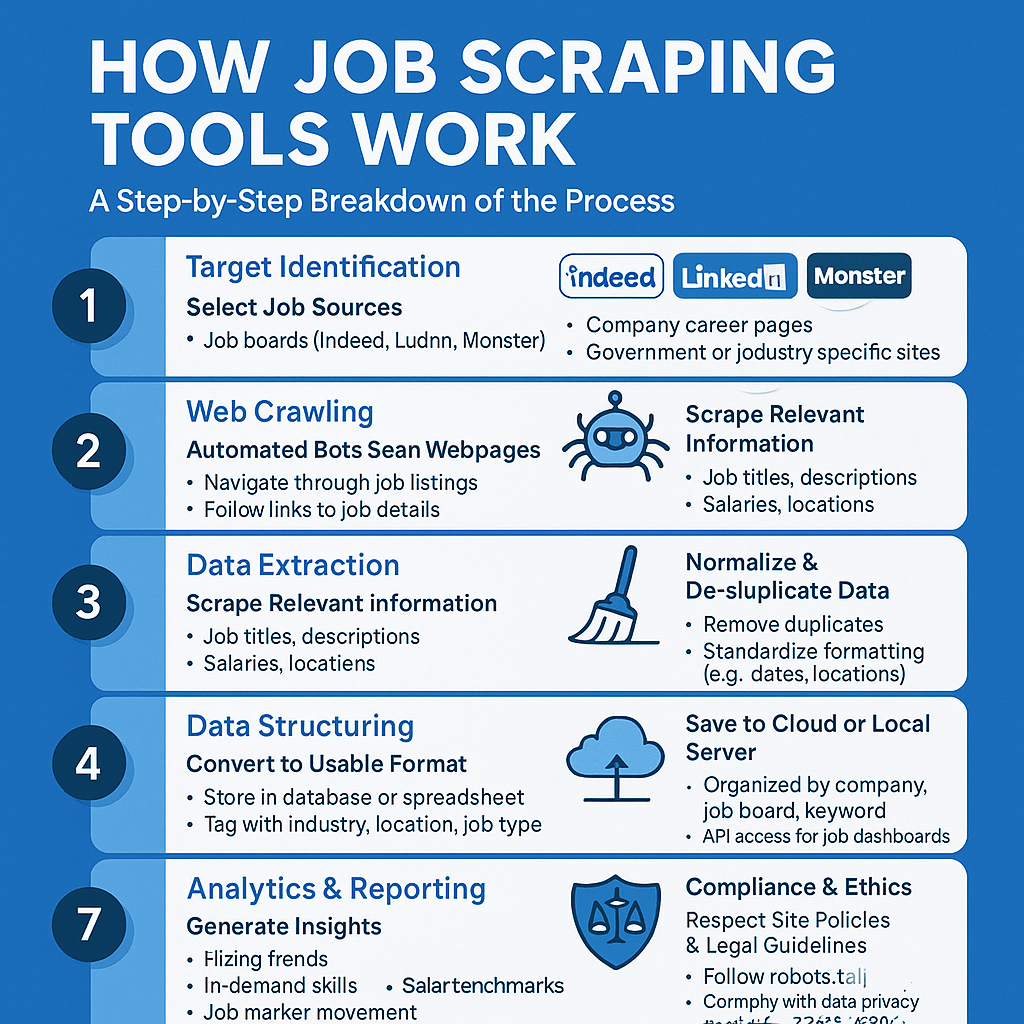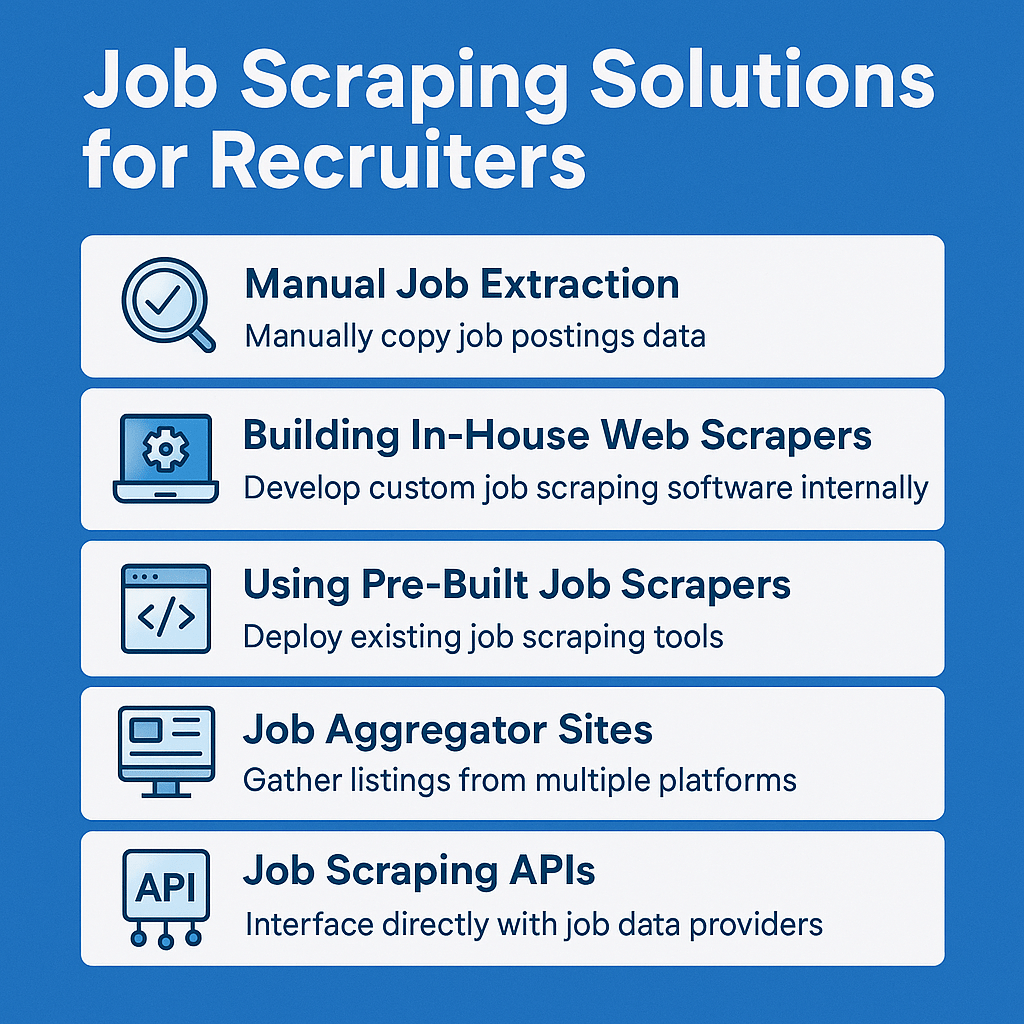Back in the day, recruiters used to wait for candidates to come to them. But things have changed. In 2025, the way companies hire people has already shifted. Now, recruiting is powered by data and smart technology, with job scraping for recruiters becoming an essential competitive advantage.
In the U.S. alone, more than 7.4 million job openings are waiting to be filled. And guess what? Around 75% of companies have said they struggle to find qualified people using the old ways. So what happened? Recruiters had to move fast. Manual methods weren’t enough anymore.
This is where web scraping for jobs came in. It helps recruiters collect job market information quickly and gives them insight into what roles are open, where, and what skills are in demand.
So, understanding how recruiters use job scraping has become crucial for modern talent acquisition strategies.
Here is why it matters
Nowadays, 75% of recruiters are using data to guide hiring choices. At the same time, two-thirds of recruiters do not have the right tools to fully understand the job market. So, when you can’t keep up, web scraping in recruitment helps bridge that gap.
Job scraping = faster hiring, smarter choices, stronger results.
Read the blog on
What is Job Scraping
Job scraping is also called job data extraction which is the automated process of collecting job listings and related information about job openings from different places on the internet.
The job scraping process involves systematically gathering data from various online sources including
- Job board websites
- Company career pages
- Other public web pages
How Does Job Scraping Work?

Instead of a person doing it by hand, special tools (called recruitment web scrapers or crawlers) do the work. They navigate across websites, find job listings, and pick out the necessary details.
After that, the tools organize everything neatly into a structured dataset. This automated approach to web scraping for job postings ensures comprehensive data collection at scale.
What Kind of Information Do Job Scraping Tools Collect?
- Job titles and descriptions
- Job qualifications, experience, education, and skills required
- Relevant company information, including business location, industry, name, and background
- Job salary and benefits
- Posting date and application deadlines
- Location and remote availability
- Industry and department
- Metadata like unique job post identifiers, company logos, and job categories
Why Every Recruiter Needs Job Scraping: Benefits
-
Enhanced Candidate Sourcing and Talent Pool Development
Web scraping for recruiters changes how you find people. You don’t just wait for applications anymore. You can build your own database of potential hires from different job sites. When you need someone, you already have a list ready.
You can also focus on specific locations.
- Need someone in Chicago? You can pull data just from that area.
- Want to compare candidates from different platforms? Easy.
You can see their skills, education, and experience all in one place through job scraping tools for recruitment.
-
Understanding the Market
This is where it gets really useful. You can scrape salary data from sites like Glassdoor to know what people are actually earning. When you’re negotiating offers, you’ll know exactly what’s fair.
You can also spy on your competitors. Not in a creepy way, but you can see what jobs they’re posting, what skills they want, and what benefits they offer. This helps you write better job descriptions and stay competitive.
-
Saving Time and Money
The numbers are pretty impressive. Job scraping can cut your recruitment costs by 30% and reduce time-to-hire by 50%. That’s because you’re not spending hours manually searching through job boards.
You can also process thousands of job postings at once.
Try doing that by hand – it would take forever.
Challenges of Job Scraping
While web scraping in recruitment offers many advantages, it often introduces some difficulties.
-
Anti-Scraping Measures
Many websites, including popular job boards like Indeed and LinkedIn, implement advanced anti-scraping techniques such as CAPTCHAs, IP blocking, rate limiting, authentication walls, honeypots, JavaScript challenges, and user behaviour analysis to deter automated activity.
-
Getting Accurate and Quality Data
Ensuring quality and accuracy is crucial. Websites frequently change their structures, which can lead to errors during extraction. Different job board websites may have varied listings, making it challenging to gather consistently structured and high-quality data.
-
Data Duplicates
Web scraping for job postings often leads to duplicate entries, especially when the same job postings appear on multiple websites. Managing and setting up systems to handle this duplicate data can be difficult.
-
Dynamic Job Boards and Content
Many modern websites use dynamic structures that load content using JavaScript (AJAX). Traditional scraping methods may struggle to gather this dynamic content, potentially leading to incomplete data.
-
Ethical and Legal Implications
Job scraping necessitates careful adherence to terms of service (ToS), digital, and labour laws. Non-compliance with data protection laws like GDPR and CCPA, especially when inadvertently collecting personal data, can lead to legal consequences, including account suspensions, lawsuits, and significant financial and reputational damages.
-
Technical Expertise and Resource Commitment
Building and maintaining an effective in-house scraping solution requires significant technical skills and resource commitment for development, maintenance, and handling issues like IP bans and HTML structure changes.
-
Data Freshness
Job postings are frequently updated or removed, meaning scraped data can quickly become outdated if scrapers are not run regularly.
Job Scraping solutions for Recruiters

Recruiters and businesses have several options for implementing effective job scraping practices to navigate these challenges.
-
Manual Job Extraction
While simple, it is time-consuming and inefficient for large datasets, making it largely unsuitable for professional recruitment efforts.
-
Building In-House Web Scrapers and Custom Scripts
Developers can create custom web scrapers and scripts using programming languages like Python with libraries such as BeautifulSoup and Scrapy, or tools like Selenium for dynamic content.
Pros: Offers greater adaptability and full control over the scraping infrastructure and data fields.
Cons: Resource-intensive and requires high technical expertise for development and ongoing maintenance due to website structure changes and anti-scraping measures.
-
Using Pre-Built Job Scrapers and No-Code Tools
Job scraping tools for recruitment like Octoparse and ParseHub offer user-friendly, point-and-click interfaces, requiring minimal to no coding knowledge.
Pros: Cost-effective by reducing development and maintenance expenses, and easily scalable.
Cons: May offer limited control over the job scraping process and might struggle with highly complex or dynamic websites.
-
Job Aggregator Sites
These sites use various web scraping methods to collect and compile information from multiple job listing sites, providing a broader picture of the job market.
Pros: Offers convenience and accessibility to large datasets without needing to build your own infrastructure.
Cons: May involve a lack of control over the data acquisition process and a risk of outdated information.
-
Job Scraping APIs
Job Scraping APIs, like Propellum, delivers customised, comprehensive, real-time job scraping solutions for job boards.
We utilise cutting-edge AI technology and an AI-driven web scraper to effectively collect job postings from trusted sources.
Our job scraper ensures a seamless collection of job listings, meticulously scanning and capturing relevant job postings from direct employer websites.
This automated solution simplifies job data collection, allowing you to focus on analysing and leveraging the data.
Our Propellum’s job scraping tool is robust, adaptable, and can be customised to specific requirements, scaling effortlessly to handle increased data volumes without compromising quality.
At the core of our tool is an advanced AI-powered web scraper. It uses machine learning, including our own AutoExtract algorithm. This algorithm keeps learning and adapting to new job description formats. That means the data stays accurate and relevant over time.
Conclusion:
In short, job scraping is a game-changer for recruiters in 2025. If you use it the right way, it helps you find better candidates faster, understand the job market, and stay ahead of your competition. You can either build your own scraping tools or use ready-made job scraping tools for recruitment, but what really matters is knowing how to use them to improve your hiring process and get better results.
Related blogs:





2 thoughts on “Why Every Recruiter Needs Job Scraping in 2025?”
Comments are closed.